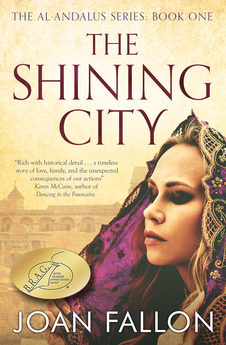
The Shining City
This is the story of a city, a city that is now in ruins: Madinat al Zahra. The year is 947 AD, a time when southern Spain is under the rule of the Moors. The ruler, Caliph al Rahman

This is the story of a city, a city that is now in ruins: Madinat al Zahra. The year is 947 AD, a time when southern Spain is under the rule of the Moors. The ruler, Caliph al Rahman

The Eye of the Falcon is the second novel in a series about Muslim Spain, set in the Andalusian city of Cordoba. By the end of the 10th century Al-Andalus was a rich and peaceful country, but when the Omayyad

It is 1008 AD, in Córdoba, the capital of the caliphate of Al-Andalus. When our story opens, al-Mansur has been dead for six years and al-Hisham II, the caliph and rightful ruler of Al-Andalus, continues to live an isolated life



OMAYYAD DYNASTY
756 – 788 ABD AL-RAHMAN I
788-796 HISHAM I
796 – 822 AL- HAKAM I
822 – 852 ABD AL-RAHMAN II
852 – 886 MUHAMMAD I
886 – 888 AL-MUNDHIR
888 – 912 ABDULLAH IBN MUHAMMAD
912 -929 Abd al-Rahman III EMIR and 929 – 961 AD caliph of al-Andalus
961 – 976 al-Hakim II caliph of al-Andalus
976 -1009 Al-Hisham II, Caliph of al-Andalus
976 – 1002 Al-Mansur, Regent & ruler of al-Andalus
1002 -1008 Abd al-Malik al-Muzaffar, ruler of al-Andalus
1008-1009 Abd al-Rahman Sanchuelo, ruler of al-Andalus
1009 ad Muhammad II, Caliph of al-Andalus
Fitna (Civil War) 1009 – 1031 AD
1009 -1010 Sulayman ibn al-Hakim, Caliph of al-Andalus
1010-1013 Al-Hisham II, Caliph of al-Andalus
1013 -1016 Sulayman ibn al-Hakim, Caliph of al-Andalus
1017 AD ABD AL-RAHMAN IV
HAMMUDID DYNASTY
1017 – 1018 ALI IBN HAMMUD AL-NASIR
1018 – 1021 AL-QASIM IBN HAMMUD AL-MA’MU
1021 – 1023 YAHYA IBN ALI IBN HAMMUD AL-MU’TALI
1023 AD AL-QASIM IBN HAMMUD AL-MA’MU
OMAYYAD DYNASTY RETURNED TO POWER
1023 -1024 ABD AL-RAHMAN V
1024 – 1025 MUHAMMAD III
1025 -1026 YAHYA IBN ALI IBN HAMMUD AL-MU’TALI
1026 – 1031 HISHAM III
Collapse of the Caliphate of Córdoba
The end of the Omayyads
The beginning of the first Taifa period
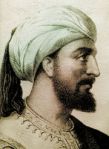 We will start by looking at the most famous man of the age. Abd al-Rahman III. He became emir of al-Andalus when he was just twenty-one. He was the grandson of the previous emir, Abdullah, who despite having four sons alive at the time of his death, chose his grandson to succeed him. His grandson had always been his favourite and he had been grooming him to take over, even giving him his ring, the symbol of his power.
We will start by looking at the most famous man of the age. Abd al-Rahman III. He became emir of al-Andalus when he was just twenty-one. He was the grandson of the previous emir, Abdullah, who despite having four sons alive at the time of his death, chose his grandson to succeed him. His grandson had always been his favourite and he had been grooming him to take over, even giving him his ring, the symbol of his power.
Al-Rahman was reputed to be a handsome young man, with pale skin, blue eyes and a reddish beard, which he liked to dye black so that his mixed blood was not so obvious. His mother was a Christian concubine, as was his grandmother, who had been the daughter of the king of Pamplona, so al-Rahman had a great deal of Christian blood in his veins.
In 912 when he became emir, the country was in disarray with dozens of small fiefdoms, and tribes whose allegiance was to their own prince, and his power extended not much further than Córdoba. In the north of Iberia, the Asturians were attempting to reclaim their lands and in north Africa the Fatimids had created an independent caliphate that threatened his rule. The governors of his cities were weak and sometimes corrupt. On top of that he was beset by internal rebellion, the most persistent of all the rebels being Omar ibn Hafsun, whose fortress was at Bobastro (near Ardales). Besides which there was constant strife between the Muslims of Arabic descent and those of Berber descent. So he was faced with an enormous task to unite al-Andalus and create a united Arab state.
His first task as emir was to introduce into his court a large number of slaves from Eastern Europe. These made up the palace guard and part of his army, and helped to neutralise the animosity between the Berbers and the Arabs.
I won’t go through all his campaigns, (which were numerous) but he began by tackling the internal threat to his rule and squashing the rebellion from al-Hafsun and his Muwallad followers, many of whom were supported by Christians. He took advantage of petty rivalries between different families to force them to submit and he gave no quarter when it came to defeating his enemies. He also removed all the old members of the Arab aristocracy from the government and appointed his own supporters
By the year 929 when the last of the rebels was killed and his head hung from a post at the gates of Cordoba, and when al-Rahman was still only 39 years old, he declared himself Caliph of al-Andalus. By doing this he broke off all allegiance to the Fatimid caliphate in north Africa and the Abbasid caliphate in Baghdad. By proclaiming himself Caliph, al-Rahman was declaring himself the successor of the prophet Muhammad. It made him not only the political leader of the Muslims in al-Andalus but also their religious leader, and the protector of his Christian and Jewish subjects. This was a shrewd move which helped him to maintain the loyalty of his subjects. His full title now became Abd al-Rahman ibn Muhammad ibn Abd Allah al Nasir li-Din Allah (Abd servant, ibn son of, defender of God’s faith)
Now that he was Caliph he turned his attention to the Christians in the north and by the year 950 AD, some 38 years after succeeding his grandfather, he had achieved peace throughout his kingdom.
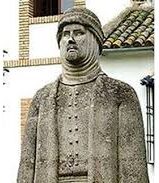 When his father died, al-Hakim inherited the throne. He was a well educated, erudite man who supported the art and culture of the time. He was, it seems, more interested in his books than running the country. There were 70 public libraries in the city at that time and over 400,000 books, plus the university libraries, private libraries and those belonging to the mosque. Al-Hakim was obsessed with them and constantly bought new books, or had copies made of books that he couldn’t obtain. He would send to Baghdad or Damascus for a book that he had heard of. The majority of the books at that time were made from parchment. The pens they used were made from quills or from sharpened pieces of reed and they used iron gall ink, a concoction of ferrous sulphate and galls mixed with wine or vinegar. The libraries were places for study and for the copying and translations of books. They were tranquil places, surrounded by lakes and gardens and usually on two floors. Rooms were carpeted so that students could sit and read in comfort and all the books were catalogued and kept on shelves. Copyists and translators were employed to translate books from Latin, Greek, Persian and Sanskrit. Many visiting scribes came from England, France and other parts of the world to copy the Arabic texts into Latin.
When his father died, al-Hakim inherited the throne. He was a well educated, erudite man who supported the art and culture of the time. He was, it seems, more interested in his books than running the country. There were 70 public libraries in the city at that time and over 400,000 books, plus the university libraries, private libraries and those belonging to the mosque. Al-Hakim was obsessed with them and constantly bought new books, or had copies made of books that he couldn’t obtain. He would send to Baghdad or Damascus for a book that he had heard of. The majority of the books at that time were made from parchment. The pens they used were made from quills or from sharpened pieces of reed and they used iron gall ink, a concoction of ferrous sulphate and galls mixed with wine or vinegar. The libraries were places for study and for the copying and translations of books. They were tranquil places, surrounded by lakes and gardens and usually on two floors. Rooms were carpeted so that students could sit and read in comfort and all the books were catalogued and kept on shelves. Copyists and translators were employed to translate books from Latin, Greek, Persian and Sanskrit. Many visiting scribes came from England, France and other parts of the world to copy the Arabic texts into Latin.
Al Rahman III had left him with the job of finishing the building of Madinat al-Zahra and maintaining the stability and peace of the country. Both of these he did. The completion of Madinat al-Zahra he did with great enthusiasm although he was not a brilliant campaigner.
What he couldn’t do was produce an heir. That was the most important task for a ruler. But al-Hakim was a homosexual and had no interest in the women in his harem. Homosexuality was common amongst the upper classes in society, and although it was forbidden by the Koran, it was widely tolerated. The story of how al-Hakim managed to produce not one but two sons is like something from a novel. His mother, now the Queen Mother, the most powerful woman in the country, instructed the chief black eunuch to find a special kind of woman for her son, someone interested in poetry and music, in literature and all the things that occupied al-Hakim’s mind. She wanted someone that he could converse with on an equal footing. The eunuch found a woman called Subh, who was a young slave of Basque origin. She was tall and slim, very intelligent and well educated, so she was groomed to seduce the reluctant caliph. The Queen Mother even instructed her to cut off her hair and dress in men’s clothing when she went to see the caliph. Even though she was obviously not a man, the caliph eventually took her to his bed and a son was born. The caliph and Subh were said to become good friends and although he had already done his duty, another son was born a couple of years later. This second son, who on the death of his older brother, became heir to the throne, was al-Hisham II.
Al-Hakem didn’t survive his father for long and in 976 AD died of apoplexy – what we would refer to today, as a stroke – when he was only 50 years old.
AL-HISHAM II, Caliph of al-Andalus 976 – 1009 AD and 1010-1013 AD
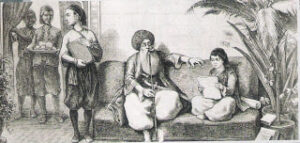 His elder brother had died when he was 8 years old and so the throne now went to young Hisham, only 11 years old at the time. How was such a young child going to rule a wealthy, complex country like al-Andalus, especially as it was surrounded by enemies?
His elder brother had died when he was 8 years old and so the throne now went to young Hisham, only 11 years old at the time. How was such a young child going to rule a wealthy, complex country like al-Andalus, especially as it was surrounded by enemies?
The new caliph, al-Hisham II had been well loved by his father but he was ill-prepared to rule the country, which was surrounded by enemies. There were the Muslim Fattamites in North Africa, just waiting for a chance to cross the straits and conquer al-Andalus. In the north of Spain were the Christian kings, many of whom had been happy to live in peace while al-Hakem was alive but couldn’t be trusted not to try to regain the land for Christianity. Then there were the Muslim princes within al-Andalus, who had been brought under the rule of al-Rahman III. This was an opportunity for them to get their lands back. And there were the cousins, uncles and half-brothers who felt they had as much right to the throne as al-Hisham. There were enemies everywhere, just waiting for the chance to attack.
A Regency was appointed to rule in al-Hisham’s place and from then on he was ignored. He received no preparation to become ruler and was held a prisoner in his palace, seeing nobody except his servants and forbidden to leave the grounds of the palace. No one feared him and no one asked anything of him. At first he did a few rudimentary duties such as signing documents, which he did not read and wouldn’t have understood if he had. But then he was not even allowed to do that. He was encouraged to live the life of a lounger, spending time playing games or in his harem. At first his mother came to see him, and lived in the harem, close by, but then she too moved to Cordoba to be with the rest of the courtiers. By the time the young caliph had come of age he had been cut off from the rest of the world. Visiting ambassadors did not ask to see him; they went straight to Al-Mansur.
This isolation affected his health and his mental stability and he gained the reputation of being a weak and despicable character, incapable of ruling. He never was given the chance to rule and in 997 AD, when he was 31 years old he was forced to hand over all power, officially to Al-Mansur.
He disappeared in 1013AD presumed dead.
The Queen Subh umm Walad
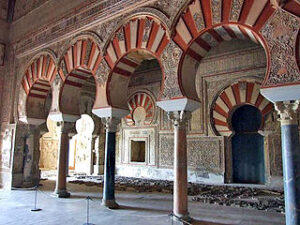
In the year 950 AD or thereabouts, a young girl was captured by slavers. She was born in the north of Spain, probably in the Kingdom of Navarra. She was blonde, blue-eyed and beautiful and I’m sure the slavers thought they would get a very good price for her from the Moorish inhabitants of al-Andalus. The girl was probably bought by an educated family in Córdoba and named Subh. While she worked for them, she learnt to read and write in Arabic and to appreciate poetry. It’s not certain why she didn’t continue to live with the family, but it was common at the time for people to educate their slaves and thereby increase their value. The slaves could then be sold as book keepers or letter writers, for example. Owning a slave was a sign of prestige and especially if that slave was educated or had a white skin.
The first time we read of the girl, she lives in the caliph’s harem. The caliph al-Hakim II was a homosexual and had no interest in the women in his harem. But the ruler of the country had to produce an heir. His mother, the Queen Mother, the most powerful woman in the country, decided to do something about this. To keep her own position secure she needed her son to produce an heir. She instructed the chief eunuch, who ran the harem, to chose a special kind of concubine for her son, someone interested in poetry and music, in literature and all the things that occupied al-Hakim’s mind. She wanted someone with whom he could converse on an equal footing.
He chose Subh, who was tall and slim, very intelligent and by now, well educated, and groomed her to seduce the reluctant caliph. The Queen Mother instructed her to cut off her hair and dress in men’s clothing when she went to see the caliph. Even though she was obviously not a man, the caliph eventually took her to his bed and a son was born. She was known from then on as Subh umm Walad (Subh, mother of a son). The caliph and Subh were said to become good friends and although he had already done his duty, another son was born a couple of years later.
The older son died when he was only 8 years-old and the younger one, al-Hisham became the heir to the throne. In 976 AD, al-Hakim II died and his young heir was only 11 years-old. Subh umm Walad was now the new Queen Mother, the most important woman in the country. She decided that a Regency should be formed to rule until her son was old enough to take control. She called together the Grand Vizier, General Ghalib and her lover, Abu Amir. They were all men she could trust – or so she thought – to protect her son.
The regents
The Grand Vizier (Royal Chamberlain) – was a man called al-Mushafi, who had been a childhood friend of the caliph, al-Hakem II. He was very loyal to the throne. He was of Berber descent and because of this, was hated by both Abu Amir and the General. Abu Amir plotted to disgrace him and engineered his fall from power. Al-Mushafi was imprisoned for 5 years on embezzlement charges and then later, after his release, he was secretly poisoned on the orders of Abu Amir.
General Ghalib had been a loyal soldier for many years and fought in many battles. Originally a slave, he had been granted his freedom in exchange for fighting in the caliph’s army. Experienced, battle-hardened, loyal and trustworthy, he had risen to the rank of general and had sworn to protect the young caliph. At first he was a supporter of Abu Amir and even gave his daughter to him in marriage, but later disagreed with Abu Amir’s policy of jihad. He died in battle in 981.
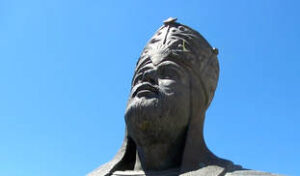
Abu Amir was of Arab descent – something that made him part of the elite – and even claimed that his descendants arrived with Tarik in the eighth century. He was a young, handsome man who took every opportunity to further his career and when no opportunity existed he made one. An example of this was when he asked to marry the General’s daughter, although he knew that the Grand Vizier had her picked out for his own son. In that way, he allied himself closer to the General and drove a wedge between the General and the Grand Vizier. From the start it looked as though he intended to take sole control of the Regency and step by step get rid of any opposition.
Early in his career, he had been given the task of managing the fortunes of Subh and her two sons and that was how they met and became lovers. Subh’s influence helped him to rise through the civil servant ranks until, after he managed to get rid of the Grand Vizier, he took the position for himself.
Abu Amir was a man who was very aware of his own image and worked hard to win the popularity of the people. As part of this image building he pretended to be very pious and took a hard line on religious practices, including burning thousands of the universities’ science books, collected over many years by Hakem II, on the grounds that they were heretical.
He also launched a jihad – holy war – against the Christian princes and fought many battles – in one year alone he fought seven campaigns and there were so many battles won that the people renamed him Al-Mansur – the Victorious One. In total he went on 57 campaigns.
In fact the jihads had little to do with religious zeal as Al-Mansur was not a zealot, his real reason behind the campaigns was to gain the wealth that a successful campaign could bring him. Not only gold and jewels from sacking the churches and castles of the Christians, but also the capture of soldiers, who were not slain – as this was forbidden under Muslim law – but enlisted into his army. Within a few years Al-Mansur had acquired an enormous private army. He was unassailable.
But in the end, the General turned against him, claiming that his war-like attitude was threatening the stability of the country. They faced each other in a battle where the General had joined forces with the Christian king Ramiro. No one is sure how the General died that day, but it is recorded that his horse was startled and threw him against the pommel of his saddle and he fell to the ground, mortally wounded. In order to make an example of his old friend, Al-Mansur had his head cut off and displayed on the ramparts of Cordoba. This meant he was now the sole regent.
After the death of the General, there was no one to oppose Al-Mansur, only Subh and even she was not powerful enough to go against him. He was in complete control. He had gradually moved all the government offices away from Madinat al Zahra, back to Cordoba and the court had followed suit. Madinat al Zahra became a ghost town – there was no one of any importance left there. Only the young caliph and his guards. By 997 AD he officially had complete control and ruled until his death in 1002 AD. He was succeeded briefly by his son Abd al-Malik.
© 2021 All rights Reserved. Joan Fallon.